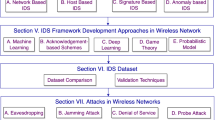Abstract
Achieving efficient security solutions for wireless sensor networks (WSN) is a daring challenge due to vulnerable nature of wireless medium. Routing is a major threat to security. An adversary can inject bogus routing to en-route nodes causing false decision and drain the sensors energy in the network system. To identify and prune the adversaries, pruning route modifiers (PRM) algorithm based on the collaborative authentication system has been proposed. The algorithm considers the random deployment of sensor nodes. Based on the collaborative authentication scheme, the PRM algorithm can save energy by pruning the malicious nodes at early stage. The simulation results and theoretical analysis reveals that PRM algorithm is effective in terms of efficient and secure routing. This algorithm reduces the consumption of energy by pruning and establishes the shortest path that leads to efficient network and enables security.










Similar content being viewed by others
References
Lu, R., Lin, X., Zhang, C., Zhu, H., Ho, P., & Shen, X. (2008). AICN: An efficient algorithm to identify compromised nodes in wireless sensor network. In Proceedings of the IEEE international conference communication (ICC’08), May 2008.
Zhou, L., & Ravishankar, C. (2005). A fault localized scheme for false report filtering in sensor networks. In Proceedings of the international conference pervasive services (ICPS’05), pp. 59–68, July 2005.
Giruka, V. C., Singhal, M., Royalty, J., & Varanasi, S. (2008). Security in wireless sensor networks. Wireless Communications and Mobile Computing, 8(1), 1–24.
Choi, H. M., Nam, S. M., & Cho, T. H. (2013). A secure routing method for detecting false reports and wormhole attacks in wireless sensor networks. Wireless Sensor Network, 5, 33–40.
Lu, R. (2012). BECAN: A bandwidth-efficient cooperative authentication scheme for filtering injected false data in wireless sensor networks. IEEE Transactions on Parallel and Distributed Systems, 23(1), 32–43.
Pu, J., Tang, X., Wang, F., & Xiong, Z. (2012). A multicast routing protocol with pruning and energy balancing for wireless sensor networks. In Proceedings of IJDSN. 2012, ACM.
Roy, S., Conti, M., & Jajodia, S. (2014). Secure data aggregation in wireless sensor networks: Filtering out the attacker’s impact. Information Forensics and Security, IEEE Transactions on, 9(4), 681–694.
Zhu, S., Setia, S., Jajodia, S., & Ning, P. (2004). An interleaved hop-by-hop authentication scheme for filtering of injected false data in sensor networks. In Proceedings of the IEEE symposium security and privacy, 2004.
Penttinen, A. (2006). Minimum cost multicast trees in adhoc networks. In Proceedings of IEEE international conference on communications (ICC’06), vol. 8, pp. 3676–3681, July 2006.
Niwat, T., Yoshito, T., &Kaoru, S. (2005). An efficient multicast routing protocol for wireless sensor networks. IEIC Technical Report 690, Institute of Electronics Information and communication Engineers, Tokyo, Japan, 2005.
Yang, H., Ye, F., Yuan, Y., Lu, S., & Arbaugh, W. (2005). Toward resilient security wireless sensor networks. In Proceedings of the sixth ACM international symposium mobile Ad Hoc networking and computing (MobiHoc’05), pp. 34–45.
Kim, J., Baek, J., & Shon, T. (2011). An efficient and scalable re-authentication protocol over wireless sensor network. IEEE Transactions on Consumer Electronics, 57(2), 516–522.
Zhou, J. (2013). Efficient and secure routing protocol based on encryption and authentication for wireless sensor networks. International Journal of Distributed Sensor Networks, 2013, 1–17. doi:10.1155/2013/108968.
Nikolidakis, S. A., Kandris, D., Vergados, D. D., & Douligeris, C. (2013). Energy efficient routing in wireless sensor networks through balanced clustering. Algorithms, 6, 29–42.
Ganesh, S., & Amutha, R. (2013). Efficient and secure routing protocol for wireless sensor networks through SNR based dynamic clustering mechanisms. IEEE Transactions on Communications and Networks, 15(4), 422–429.
Fujin, L., Meijie, H., Hongge, R., & Wenbin, Z. (2014). A neural network algorithm for fast pruning based on remarkable analysis. In Control and Decision Conference (2014 CCDC), pp. 184–188.
Sakharkar, S. M., Mangrulkar, R. S., Atique, M. (2014). A survey: A secure routing method for detecting false reports and gray-hole attacks along with Elliptic Curve Cryptography in wireless sensor networks. In IEEE students conference on electrical, electronics and computer science, pp. 1–5, March 2014.
Khalid, Z., Durrani, S., &Guo, J. (2013). A tractable framework for exact probability of node isolation and minimum node degree distribution in finite multi-hop networks. arXiv, Nov 2013.
Vavoulas, A., Sandalidis, H. G., & Varoutas, D. (2011). Node isolation probability for serial ultraviolet UV-C multi-hop networks. Journal of Optical Communications Networking, 3(9), 750–757.
Bettstetter, C. (2002). On the minimum node degree and connectivity of a wireless multihop network. ACM 1-58113-501-7/02/0006. pp 80–91.
Zhang, C., Lu, R., Lin, X., Ho, P., & Shen, X. (2008). An efficient identity-based batch verification scheme for vehicular sensor networks. In Proceedings of the IEEE INFOCOM’08, Apr. 2008.
Zhang, W., Han, G., Feng, Y., Cheng, L., Zhang, D., Tan, X., & Fu, L. (2015). A novel method for node fault detection based on clustering in industrial wireless sensor networks. International Journal of Distributed Sensor Networks, 9. Article ID 230521.
Wong, K. P. (2015). Trouble-shooting the key problems of overhead and pinball routing in nested mobile network. First Asia Pacific Conference on Advanced Research (APCAR-2015), ISBN: 978 0 994 3656 68.
Jay, L. D. (2012). Probability and statistics for engineering and sciences, Eighth Edition, California Polytechnic State university, San Luis Obispo, Brooks/Cole Cengage Learning, USA.
Author information
Authors and Affiliations
Corresponding author
Rights and permissions
About this article
Cite this article
Usha, M., Vanitha, C.N. Pruning Route Modifiers in Wireless Sensor Networks. Wireless Pers Commun 89, 27–43 (2016). https://doi.org/10.1007/s11277-016-3249-1
Published:
Issue Date:
DOI: https://doi.org/10.1007/s11277-016-3249-1




